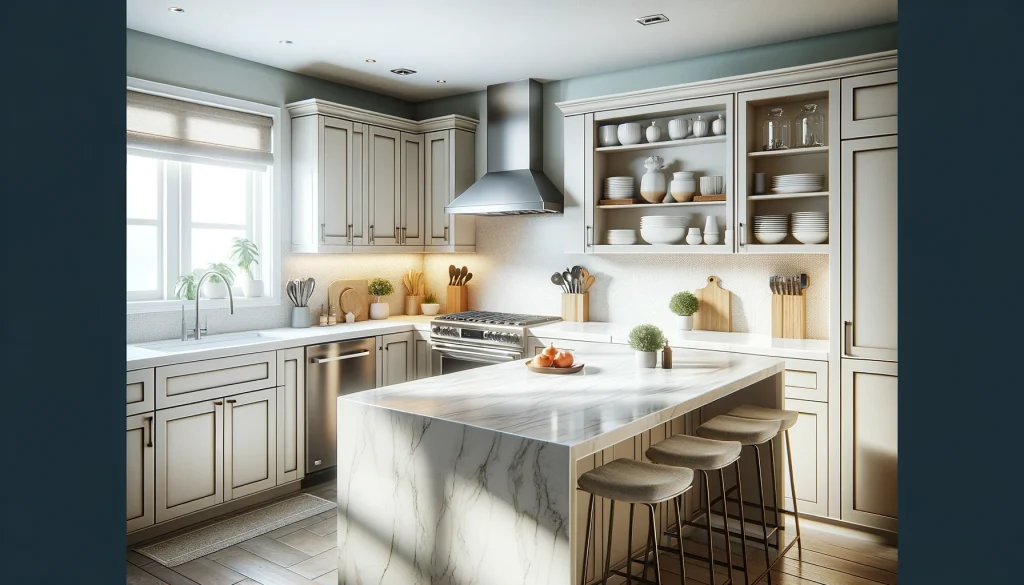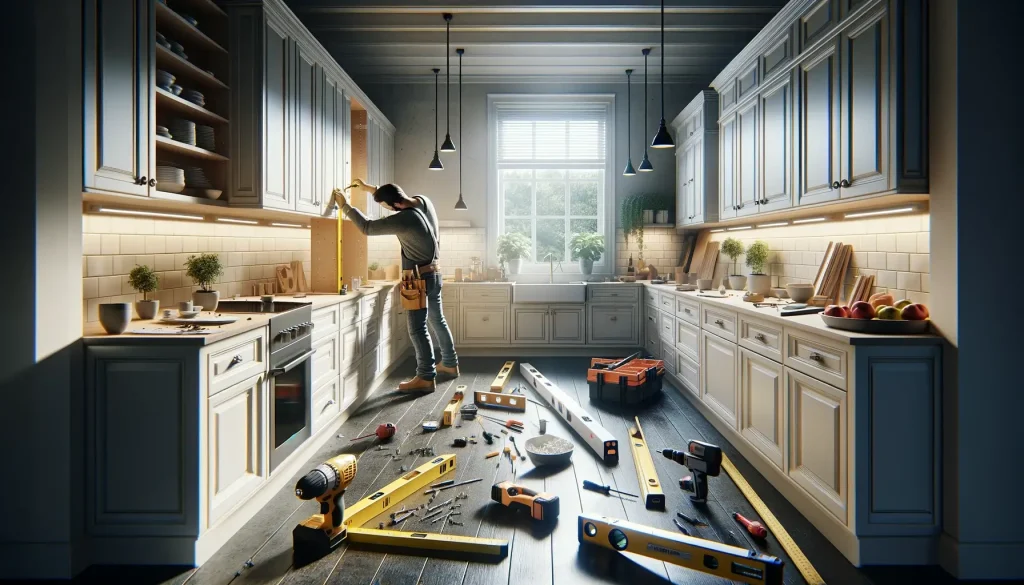Kitchen cabinet installation typically takes around 1-2 days, depending on the complexity and size of the project. Welcome to our guide on kitchen cabinet installation time.
Installing kitchen cabinets is an essential part of any kitchen renovation or remodeling project. It is important to plan the timeline accordingly to ensure a smooth and efficient installation process. The duration of the installation will depend on various factors, such as the number of cabinets, the size of the kitchen, and any additional customization required.
In general, most kitchen cabinet installations can be completed within 1-2 days. However, larger or more complex projects may take longer. It is advisable to consult with a professional contractor to get a more accurate estimate based on your specific requirements.

Factors Affecting Installation Time
When it comes to installing kitchen cabinets, several factors can influence the time it takes to complete the project. Understanding these variables can help you plan your kitchen renovation timeline effectively and ensure a smooth installation process. Let’s explore the key factors that can affect the installation time:
Cabinet Design Complexity
The complexity of the cabinet design is a crucial factor in determining the installation time. The more intricate the design, the longer it is likely to take to install the cabinets. Designs that include unique angles, curves, or specialized storage features may require more time and precision during installation. Additionally, cabinets with intricate trim or molding details may take longer to ensure a perfect fit and finish. It is essential to consider the complexity of your cabinet design when estimating the installation time.
Size Of The Kitchen
The size of your kitchen plays a significant role in determining the installation time for kitchen cabinets. Naturally, larger kitchens with more cabinets will take longer to install compared to smaller kitchens. The number of cabinets to be installed and the distance between them can impact the overall installation time. Additionally, a larger kitchen may require more time for precise measurements, leveling, and aligning the cabinets accurately. Therefore, it is important to factor in the size of your kitchen when planning for cabinet installation.

Pre-installation Preparation
Prior to the actual installation process, it is important to undertake several essential pre-installation steps to ensure a smooth and efficient installation of kitchen cabinets. By taking the time to measure and plan accordingly, as well as clearing the work area, you can help minimize any potential issues and maximize the outcome of your cabinetry installation. Let’s take a closer look at these key pre-installation preparations.
Measuring And Planning
One of the first steps in the pre-installation process is accurately measuring and planning for your new kitchen cabinets. This essential step helps prevent any future headaches or delays. Start by measuring the dimensions of your kitchen space, taking into account any corners, uneven walls, or appliances that may affect the placement of your cabinets. With these measurements in hand, you can then create a detailed plan or layout, ensuring the proper fit and functionality of your new cabinets.
Clearing The Work Area
Another crucial aspect of pre-installation preparation is clearing the work area. By removing any existing cabinets, appliances, or obstructions, you provide the installers with a clean and unobstructed area to work in. This step helps streamline the installation process and ensures that the cabinets can be installed securely and efficiently. Additionally, clearing the work area allows installers to have easy access to the necessary tools and materials, facilitating a more seamless installation experience.
By investing time and effort into thorough pre-installation preparation, you set the stage for a successful installation of your kitchen cabinets. Measuring and planning accurately and clearing the work area are essential steps that contribute to a smooth and hassle-free installation process. By adhering to these necessary preparations, you can ensure that your kitchen cabinets will be installed efficiently and with optimal results.
Demolition And Removal
Installing kitchen cabinets typically takes around 2-3 days with professional demolition and removal services. This process involves careful planning, precise measuring, and skilled labor to ensure a seamless fit and finish. The timeframe may vary depending on the scope of work, the complexity of the project, and any unforeseen challenges that may arise during the installation process.
Demolition and Removal. When it comes to installing new kitchen cabinets, the first step is to demolish and remove the old cabinets. This process involves careful planning and execution to ensure a smooth transition to the new cabinets. Let’s delve into the details of the demolition and removal process.
Removing Old Cabinets
The first step in the demolition process is to carefully remove the old cabinets. This involves unscrewing them from the walls and countertops. Using a crowbar or pry bar, the cabinets are carefully loosened and removed to minimize damage to the surrounding walls and surfaces.
Disposing Of Debris
Once the old cabinets are removed, the next step is to dispose of the debris. This includes the old cabinets, countertops, and any other materials that were demolished during the removal process. The debris is typically loaded onto a dumpster or taken to a waste disposal site for proper disposal.
The demolition and removal phase is a crucial first step in the installation of new kitchen cabinets. By carefully removing the old cabinets and disposing of the debris, it sets the stage for a smooth and efficient installation process.
Read more blogs: How to Remove Kitchen Cabinets: A Step-by-Step Guide in 2024

Installation Process
The installation process of kitchen cabinets involves several key steps from assembling cabinets to mounting cabinets.
Assembling Cabinets
- Gather all necessary components and tools.
- Follow the manufacturer’s instructions for assembly.
- Ensure each piece fits together snugly.
Mounting Cabinets
- Measure and mark the layout on the wall.
- Secure the cabinets to the wall studs.
- Adjust the cabinets for proper alignment.
Customization And Detailing
When it comes to Customization and Detailing of kitchen cabinets, the customization process can add time to the overall installation.
Fitting Hardware
The process of fitting hardware involves securely attaching handles, knobs, and hinges to the cabinet doors and drawers.
- Ensure hardware is aligned for a seamless appearance
- Proper fitting of hardware enhances the aesthetic appeal of the cabinets
Adjusting For Alignment
Adjusting for alignment is crucial to ensure that all cabinet doors and drawers are level and properly positioned.
- Alignment adjustments are made to prevent any gaps or misalignments
- Proper alignment ensures smooth operation of cabinet doors and drawers
Read more blogs: Trusted Guide to Finding the Perfect Kitchen Organizer: Unveiling Real Features
Countertop Installation
When it comes to the installation of kitchen cabinets, the countertop installation is a crucial step that requires precision and attention to detail.
Measuring And Cutting
The first step in countertop installation is to measure and cut the countertop materials to fit the space properly. This requires accurate measurements and precise cutting tools to ensure the perfect fit.
Attaching Countertops
Once the countertops are cut to size, the next step is attaching the countertops to the base cabinets. This involves carefully positioning the countertops and securing them in place to create a seamless and sturdy surface for the kitchen.

Finishing Touches
The installation of kitchen cabinets is almost complete, but there are still a few important finishing touches that need to be done. These final details not only enhance the overall appearance of your kitchen but also ensure that the cabinets are properly installed and functioning as intended. In this section, we will discuss two crucial aspects of the finishing touches for kitchen cabinet installation: trim and molding, and final inspections.
Trim And Molding
Trim and molding play a significant role in giving your kitchen cabinets a polished and refined look. They conceal any gaps between the cabinets and the walls or ceilings, providing a seamless and cohesive appearance. Additionally, trim and molding help protect the edges of the cabinets from wear and tear.
There are various types of trim and molding options available, allowing you to choose the style that best suits your kitchen’s design. Crown molding is a popular choice that adds elegance and sophistication to the top of the cabinets. It creates a smooth transition between the cabinets and the ceiling, giving your kitchen a more aesthetically pleasing look.
Toe kick molding is another essential component of kitchen cabinet finishing touches. It is installed at the base of the cabinets, covering the gap between the cabinets and the floor. Not only does it provide a polished appearance, but it also protects the bottom edges of the cabinets from damage caused by dust, dirt, or accidental kicks.
When it comes to trim and molding installation, it’s crucial to ensure precise measurements and proper fitting. Professional installers will carefully cut and shape the trim and molding to fit seamlessly with the cabinets, ensuring a flawless finish. The time required for this process largely depends on the complexity of your kitchen layout, the number of cabinets, and the specific type of trim and molding being installed.
Final Inspections
Once the trim and molding are in place, the final step of the installation process is conducting thorough inspections. These inspections are crucial to ensure that the cabinets are securely installed and functioning correctly. Here’s what the final inspections entail:
- Check for proper alignment: Inspectors will carefully examine all the cabinets to ensure they are properly aligned, both horizontally and vertically. This includes checking for even gaps between cabinets and ensuring that they are level and plumb.
- Test functionality: Each cabinet’s doors, drawers, and hardware will be thoroughly tested for functionality. This involves opening and closing the doors to ensure smooth operation, checking the drawers for proper alignment and smooth gliding, and testing the hardware to ensure it is secure.
- Inspect the finish: Inspectors will scrutinize the finish and surface of the cabinets for any imperfections, scratches, or damage. Any issues found will be documented for necessary touch-ups or repairs.
These final inspections ensure that your kitchen cabinets are not only visually appealing but also meet the highest standards of quality and functionality. Once the inspections are completed and any necessary adjustments or touch-ups are made, your kitchen cabinet installation will be considered finished, and you can fully enjoy your newly transformed kitchen!

Tips For Efficient Installations
Installing kitchen cabinets can be a time-consuming process, but with the right approach, you can streamline the installation and complete the project smoothly. In this section, we will discuss some valuable tips for efficient installations.
Utilizing Professional Help
If you are short on time or lack the necessary skills, hiring a professional installer can save you a significant amount of effort and ensure a high-quality installation. Professionals have the expertise and experience to handle the installation efficiently, reducing the overall time required. Additionally, they have access to specialized tools that can expedite the process and guarantee precise measurements.
Before hiring a professional, make sure to research and vet potential candidates. Look for licensed and insured installers who have positive customer reviews. Communicate your project requirements clearly and ask for an estimated time frame for completion. This will help you make an informed decision and ensure a seamless installation.
Proper Time Management
Proper time management is essential to ensure a smooth and efficient installation process. Adequate planning and scheduling can help you avoid unnecessary delays and setbacks. Here are some tips:
- Create a detailed project plan, outlining each step of the installation process.
- Allocate sufficient time for each task, considering factors like cabinet size, complexity, and any additional requirements.
- Coordinate with other professionals involved, such as electricians or plumbers, to ensure their tasks align with the cabinet installation schedule.
- Order cabinets and materials well in advance to avoid delays caused by backorders or shipping issues.
- Set realistic deadlines and prioritize tasks based on their dependencies and criticality.
By following these time management tips, you can optimize the installation process and minimize any potential disruptions.

Credit: www.mrhandyman.com
How long does it take to install kitchen cabinets?
How long does it take to install kitchen cabinets? The time required for installing kitchen cabinets can vary depending on factors such as the size of the kitchen, the complexity of the cabinet design, and the experience level of the installer. On average, it can take anywhere from a few days to a couple of weeks to complete the installation process.
For more detailed information, you can visit how long does it take to install kitchen cabinets.
Frequently Asked Questions On How Long Does It Take To Install Kitchen Cabinets
How Long Does It Typically Take To Install Kitchen Cabinets?
Installing kitchen cabinets usually takes 1-2 days for small kitchens and 2-3 days for larger kitchens, depending on complexity.
What Factors Can Influence The Installation Time Of Kitchen Cabinets?
The size of the kitchen, the number of cabinets, the complexity of the design, and the experience of the installer can all influence installation time.
What Are The Steps Involved In The Installation Of Kitchen Cabinets?
The installation process typically involves measuring and marking, attaching the cabinets to the wall, leveling and securing them, adding finishing touches.
Is It Necessary To Hire A Professional For Installing Kitchen Cabinets?
While it’s possible to DIY, hiring a professional ensures proper installation, saving time and potential costly mistakes in the long run.
Conclusion
The time it takes to install kitchen cabinets varies based on multiple factors. Proper planning, skilled labor, and efficient tools can significantly reduce the installation time. By understanding the process and seeking professional help, homeowners can streamline the installation process and enjoy their new kitchen cabinets sooner.






